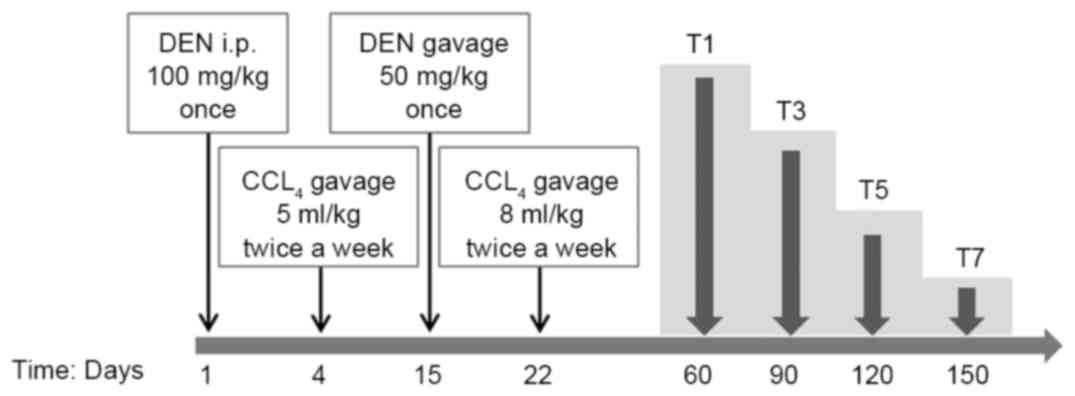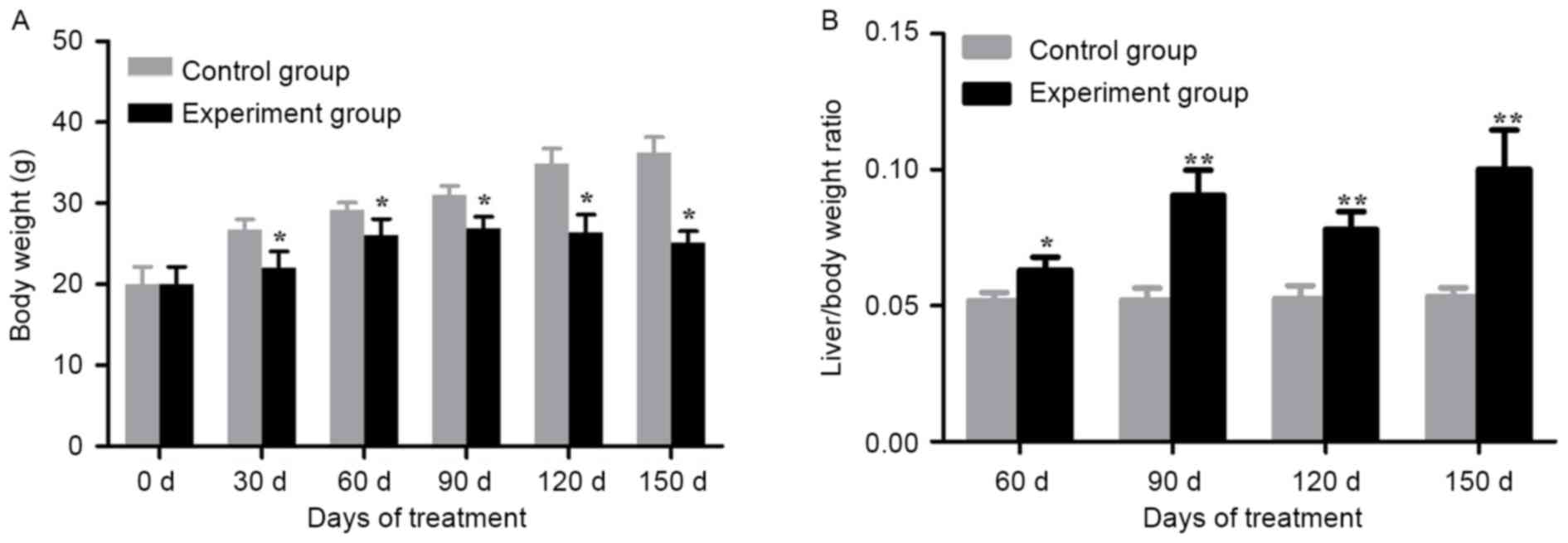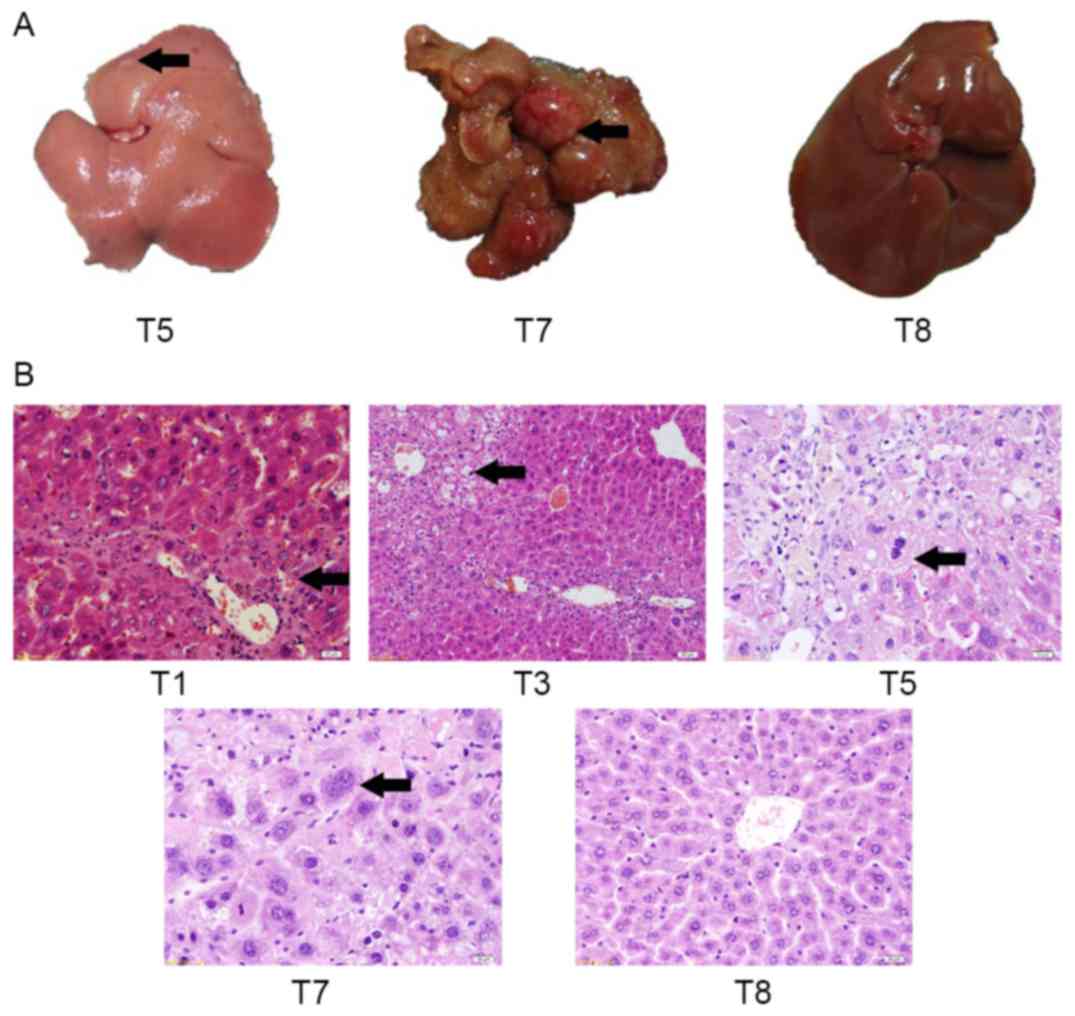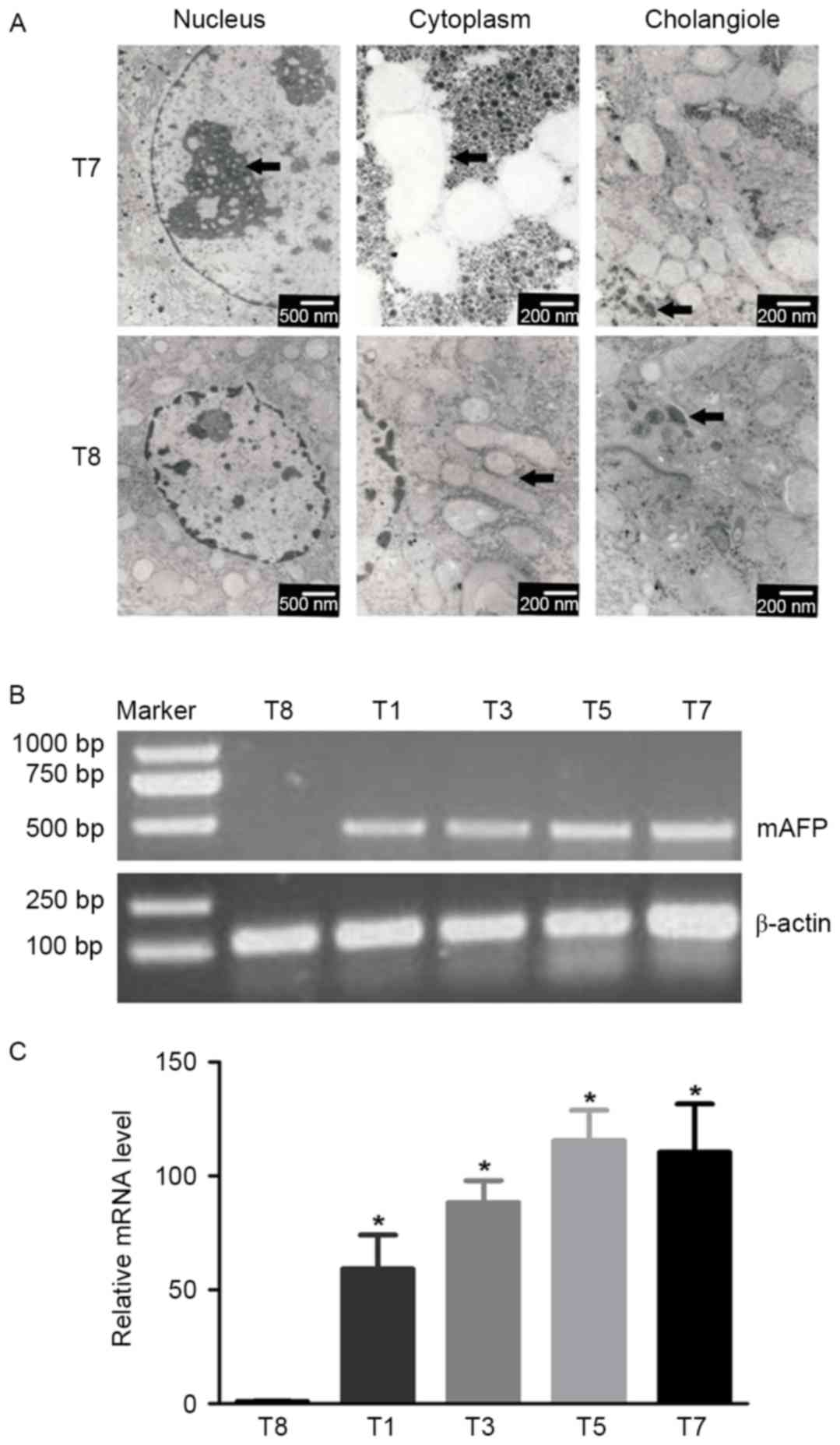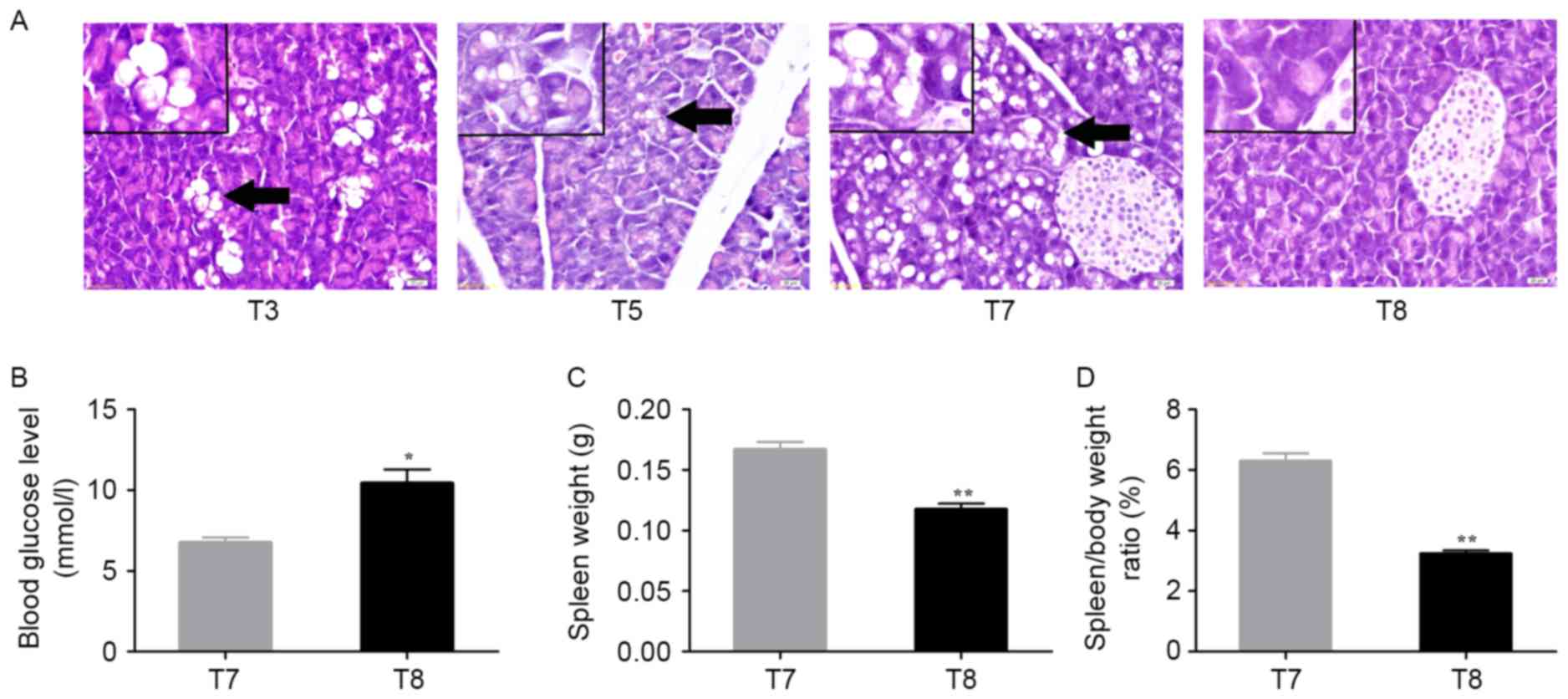|
1
|
Nordenstedt H, White DL and El-Serag HB:
The changing pattern of epidemiology in hepatocellular carcinoma.
Dig Liver Dis. 42 Suppl 3:S206–S214. 2010. View Article : Google Scholar : PubMed/NCBI
|
|
2
|
Dhanasekaran R, Limaye A and Cabrera R:
Hepatocellular carcinoma: Current trends in worldwide epidemiology,
risk factors, diagnosis, and therapeutics. Hepat Med. 4:19–37.
2012.PubMed/NCBI
|
|
3
|
Kassebaum NJ, Bertozzi-Villa A, Coggeshall
MS, Shackelford KA, Steiner C, Heuton KR, Gonzalez-Medina D, Barber
R, Huynh C, Dicker D, et al: Global, regional, and national levels
and causes of maternal mortality during 1990–2013: A systematic
analysis for the Global Burden of Disease Study 2013. Lancet.
384:980–1004. 2014. View Article : Google Scholar : PubMed/NCBI
|
|
4
|
Calle EE, Rodriguez C, Walker-Thurmond K
and Thun MJ: Overweight, obesity, and mortality from cancer in a
prospectively studied cohort of U.S. adults. N Engl J Med.
348:1625–1638. 2003. View Article : Google Scholar : PubMed/NCBI
|
|
5
|
Siegel R, Ma J, Zou Z and Jemal A: Cancer
statistics, 2014. CA Cancer J Clin. 64:9–29. 2014. View Article : Google Scholar : PubMed/NCBI
|
|
6
|
Sherman M: The resurrection of
alphafetoprotein. J hepatol. 52:939–940. 2010. View Article : Google Scholar : PubMed/NCBI
|
|
7
|
Bertino G, Neri S, Bruno CM, Ardiri AM,
Calvagno GS, Malaguarnera M, Toro A, Malaguarnera M, Clementi S,
Bertino N and Di Carlo I: Diagnostic and prognostic value of
alpha-fetoprotein, des-γ-carboxy prothrombin and squamous cell
carcinoma antigen immunoglobulin M complexes in hepatocellular
carcinoma. Minerva Med. 102:363–371. 2011.PubMed/NCBI
|
|
8
|
Bakiri L and Wagner EF: Mouse models for
liver cancer. Mol Oncol. 7:206–223. 2013. View Article : Google Scholar : PubMed/NCBI
|
|
9
|
Rajewsky MF, Dauber W and Frankenberg H:
Liver carcinogenesis by diethylnitrosamine in the rat. Science.
152:83–85. 1966. View Article : Google Scholar : PubMed/NCBI
|
|
10
|
Qi Y, Chen X, Chan CY, Li D, Yuan C, Yu F,
Lin MC, Yew DT, Kung HF and Lai L: Two-dimensional differential gel
electrophoresis/analysis of diethylnitrosamine induced rat
hepatocellular carcinoma. Int J Cancer. 122:2682–2688. 2008.
View Article : Google Scholar : PubMed/NCBI
|
|
11
|
Park EJ, Lee JH, Yu GY, He G, Ali SR,
Holzer RG, Osterreicher CH, Takahashi H and Karin M: Dietary and
genetic obesity promote liver inflammation and tumorigenesis by
enhancing IL-6 and TNF expression. Cell. 140:197–208. 2010.
View Article : Google Scholar : PubMed/NCBI
|
|
12
|
Diwan BA, Rice JM, Ohshima M and Ward JM:
Interstrain differences in susceptibility to liver carcinogenesis
initiated by N-nitrosodiethylamine and its promotion by
phenobarbital in C57BL/6NCr, C3H/HeNCrMTV- and DBA/2NCr mice.
Carcinogenesis. 7:215–220. 1986. View Article : Google Scholar : PubMed/NCBI
|
|
13
|
Pok S, Wen V, Shackel N, Alsop A, Pyakurel
P, Fahrer A, Farrell GC and Teoh NC: Cyclin E facilitates
dysplastic hepatocytes to bypass G1/S checkpoint in
hepatocarcinogenesis. J Gastroenterol Hepatol. 28:1545–1554. 2013.
View Article : Google Scholar : PubMed/NCBI
|
|
14
|
Wong VW and Janssen HL: Can we use HCC
risk scores to individualize surveillance in chronic hepatitis B
infection? J Hepatol. 63:722–732. 2015. View Article : Google Scholar : PubMed/NCBI
|
|
15
|
Da Costa RM, Paula-Santos N, Rocha AF,
Colaco A, Lopes C and Oliveira PA: The N-nitrosodiethylamine mouse
model: Sketching a timeline of evolution of chemically-induced
hepatic lesions. Anticancer Res. 34:7029–7037. 2014.PubMed/NCBI
|
|
16
|
Szabo G: Gut-liver axis in alcoholic liver
disease. Gastroenterology. 148:30–36. 2015. View Article : Google Scholar : PubMed/NCBI
|
|
17
|
Mandrekar P, Ambade A, Lim A, Szabo G and
Catalano D: An essential role for monocyte chemoattractant
protein-1 in alcoholic liver injury: Regulation of proinflammatory
cytokines and hepatic steatosis in mice. Hepatology. 54:2185–2197.
2011. View Article : Google Scholar : PubMed/NCBI
|
|
18
|
Szabo G, Petrasek J and Bala S: Innate
immunity and alcoholic liver disease. Dig Dis. 30 Suppl 1:S55–S60.
2012. View Article : Google Scholar
|
|
19
|
Wheeler MD, Kono H, Yin M, Nakagami M,
Uesugi T, Arteel GE, Gäbele E, Rusyn I, Yamashina S, Froh M, et al:
The role of Kupffer cell oxidant production in early
ethanol-induced liver disease. Free Radic Biol Med. 31:1544–1549.
2001. View Article : Google Scholar : PubMed/NCBI
|
|
20
|
Enomoto N, Ikejima K, Bradford BU, Rivera
CA, Kono H, Goto M, Yamashina S, Schemmer P, Kitamura T, Oide H, et
al: Role of Kupffer cells and gut-derived endotoxins in alcoholic
liver injury. J Gastroenterol Hepatol. 15 Suppl:D20–D25. 2000.
View Article : Google Scholar : PubMed/NCBI
|
|
21
|
Uesugi T, Froh M, Arteel GE, Bradford BU
and Thurman RG: Toll-like receptor 4 is involved in the mechanism
of early alcohol-induced liver injury in mice. Hepatology.
34:101–108. 2001. View Article : Google Scholar : PubMed/NCBI
|
|
22
|
Petrasek J, Mandrekar P and Szabo G:
Toll-like receptors in the pathogenesis of alcoholic liver disease.
Gastroenterol Res Pract. 2010:pii:7103812010. View Article : Google Scholar
|
|
23
|
Dapito DH, Mencin A, Gwak GY, Pradere JP,
Jang MK, Mederacke I, Caviglia JM, Khiabanian H, Adeyemi A,
Bataller R, et al: Promotion of hepatocellular carcinoma by the
intestinal microbiota and TLR4. Cancer Cell. 21:504–516. 2012.
View Article : Google Scholar : PubMed/NCBI
|
|
24
|
Machida K, Tsukamoto H, Mkrtchyan H, Duan
L, Dynnyk A, Liu HM, Asahina K, Govindarajan S, Ray R, Ou JH, et
al: Toll-like receptor 4 mediates synergism between alcohol and HCV
in hepatic oncogenesis involving stem cell marker Nanog. Proc Natl
Acad Sci USA. 106:1548–1553. 2009. View Article : Google Scholar : PubMed/NCBI
|
|
25
|
Kapanadze T, Gamrekelashvili J, Ma C, Chan
C, Zhao F, Hewitt S, Zender L, Kapoor V, Felsher DW, Manns MP, et
al: Regulation of accumulation and function of myeloid derived
suppressor cells in different murine models of hepatocellular
carcinoma. J Hepatol. 59:1007–1013. 2013. View Article : Google Scholar : PubMed/NCBI
|
|
26
|
El-Serag HB, Kanwal F, Davila JA, Kramer J
and Richardson P: A new laboratory-based algorithm to predict
development of hepatocellular carcinoma in patients with hepatitis
C and cirrhosis. Gastroenterology. 146:1249–1255.e1. 2014.
View Article : Google Scholar : PubMed/NCBI
|
|
27
|
Farazi PA and DePinho RA: Hepatocellular
carcinoma pathogenesis: From genes to environment. Nat Rev Cancer.
6:674–687. 2006. View
Article : Google Scholar : PubMed/NCBI
|
|
28
|
Thorgeirsson SS and Grisham JW: Molecular
pathogenesis of human hepatocellular carcinoma. Nat Genet.
31:339–346. 2002. View Article : Google Scholar : PubMed/NCBI
|
|
29
|
Teufel A, Maass T, Strand S, Kanzler S,
Galante T, Becker K, Strand D, Biesterfeld S, Westphal H and Galle
PR: Liver-specific Ldb1 deletion results in enhanced liver cancer
development. J Hepatol. 53:1078–1084. 2010. View Article : Google Scholar : PubMed/NCBI
|
|
30
|
Cai Z, Lou Q, Wang F, Li E, Sun J, Fang H,
Xi J and Ju L: N-acetylcysteine protects against liver injure
induced by carbon tetrachloride via activation of the Nrf2/HO-1
pathway. Int J Clin Exp Pathol. 8:8655–8662. 2015.PubMed/NCBI
|
|
31
|
Saran U, Humar B, Kolly P and Dufour JF:
Hepatocellular Carcinoma and Lifestyles. J Hepatol. 64:203–214.
2016. View Article : Google Scholar : PubMed/NCBI
|
|
32
|
Neuman MG, Maor Y, Nanau RM, Melzer E,
Mell H, Opris M, Cohen L and Malnick S: Alcoholic liver disease:
Role of cytokines. Biomolecules. 5:2023–2034. 2015. View Article : Google Scholar : PubMed/NCBI
|



